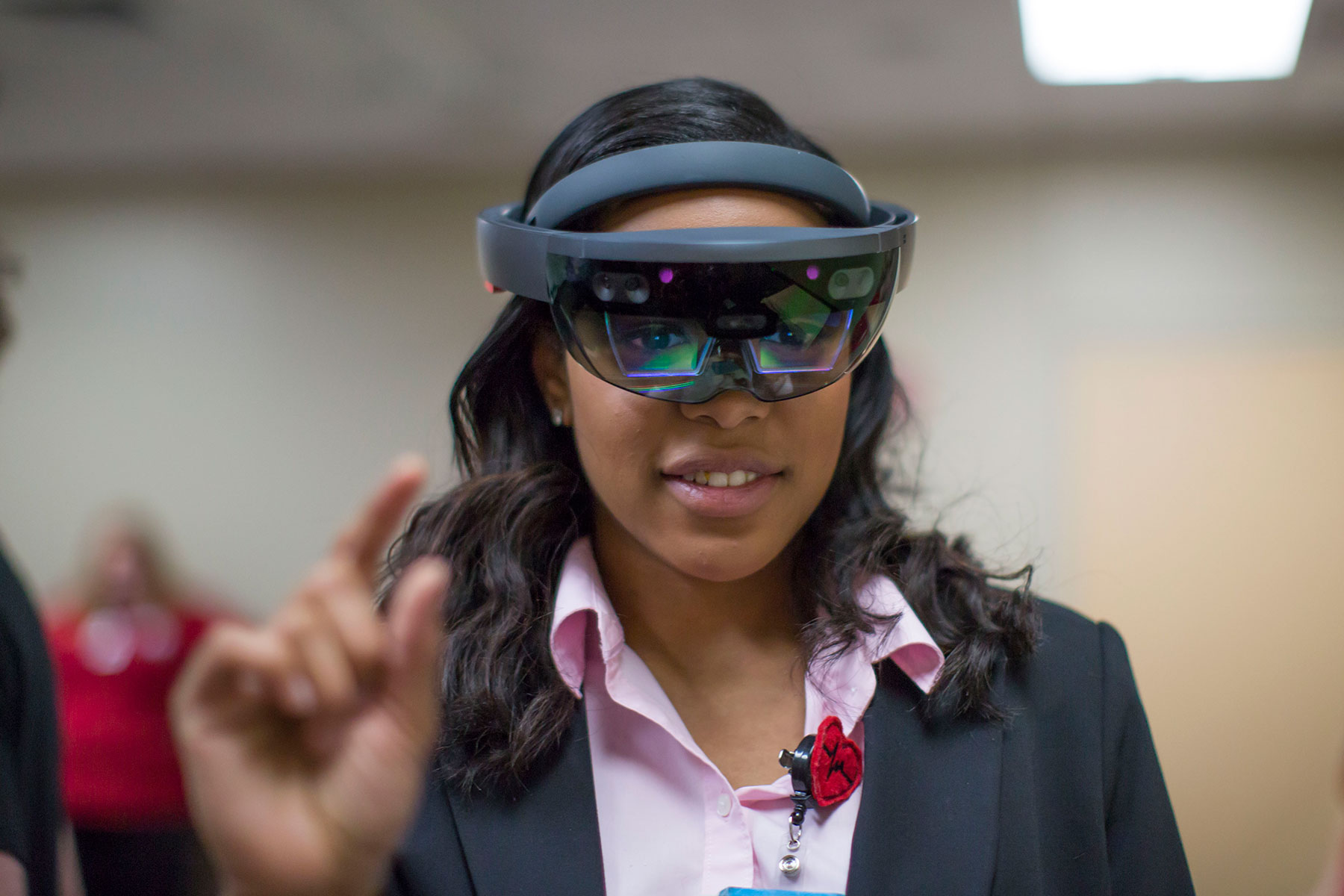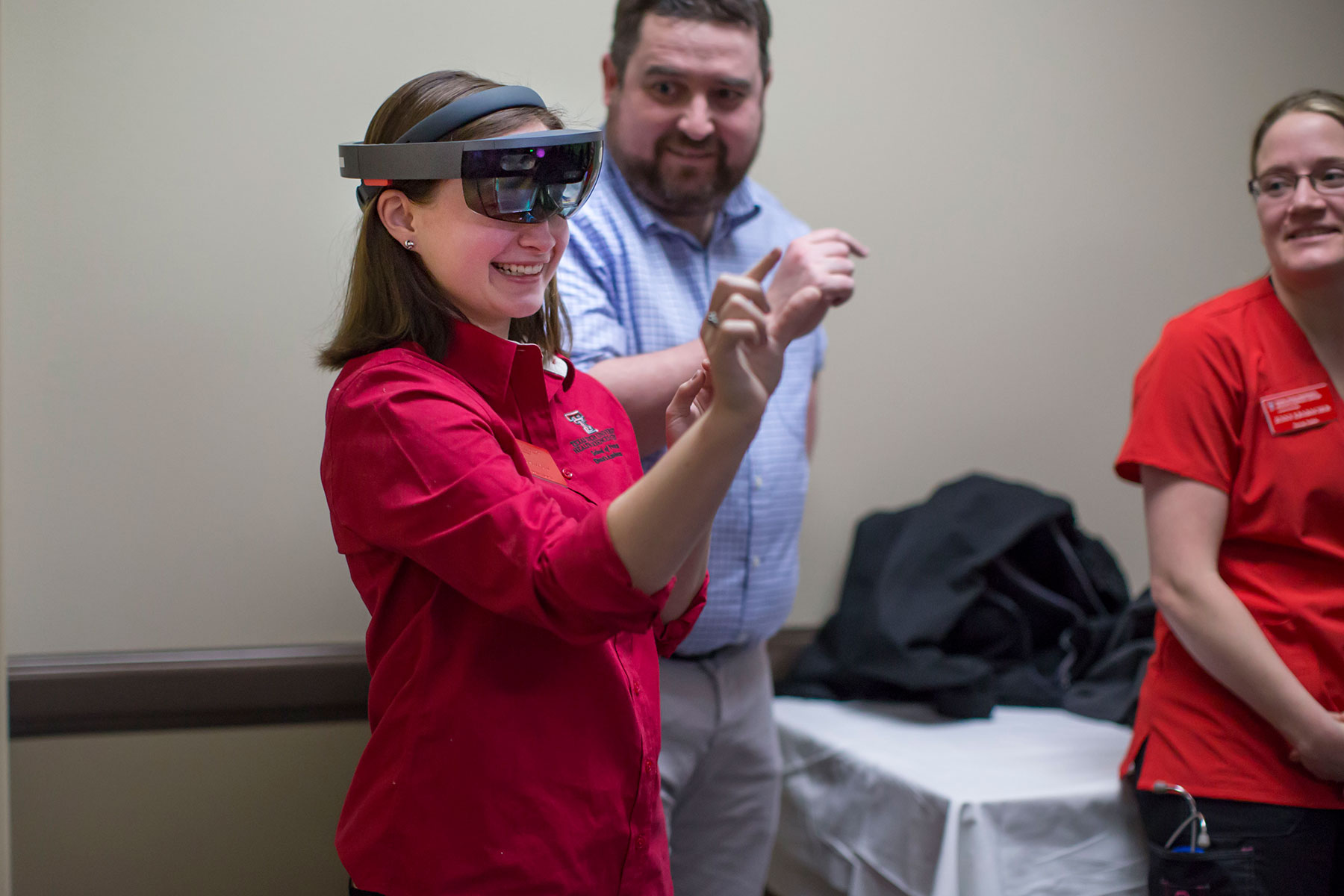Foresight: TTUHSC Peers into the Future with Pearson
A patient is sitting on a table, unresponsive to touch and his condition continues to worsen. In one reality, a created reality, this is true, but when the student takes off the head-mounted computer, the patient is gone. This apparition was manifested in the Texas Tech University Health Sciences Center (TTUHSC) F. Marie Hall Simlife Center using Pearson’s educational simulation technology which incorporates Microsoft’s HoloLens, the world’s first untethered, head-mounted computer.

Pearson is the world’s learning company, with expertise in educational courseware and assessment, and a range of teaching and learning services powered by technology. The company’s mission is to help people make progress through access to better learning. Pearson chose to conduct pilot studies at the simulation centers of TTUHSC and San Diego State University. In the first study conducted in February, 13 TTUHSC nursing students were chosen to be a part of Pearson’s development phase focus group for the new simulation headset. They are now part of the few people, aside from the engineers, who have experienced the Holographic Capture technology delivered by the HoloLens.
“Through our innovative partnership with Texas Technical University Health Sciences Center, we are transforming teaching and learning to increase student success in the classroom, which will ultimately help to produce a more effective nursing workforce,” Global Director of Immersive Learning Mark Christian, Pearson, said. “By harnessing the power of Holographic technology, educators are empowered with superior teaching aids that significantly increase students’ level of engagement and comprehension. The technology also provides educators with valuable insights into students’ learning activity through data access, enabling instructors to track and analyze how well their students comprehend the lessons.”
Students donned the goggles to begin their patient encounter, with the patient sitting in a chair in the room. A menu appears, giving viewers an option to see the patient’s state change. Many of the students have seen him before, as the actor is a regular standardized patient on the floor of the F. Marie Hall Simlife Center.
"Here at Pearson's Immersive team, we're fortunate to work with a host of world-class partners, and Texas Tech is no exception,” Head of Immersive Teaching & Implementation Matthew Scott, Pearson, said. “Our workshops with both faculty and students have been enthusiastically received, and we are delighted with the results so far. Everyone involved in this project is excited at the transformational potential of this technology and our partnerships with both TTU and SDSU are fundamental to achieving that potential.”
“This adds another dimension to learning,” Associate Dean for Simulation Sharon Decker, Ph.D., R.N., said. “Pearson is solving real problems in medical education. The extra depth created by this computer will change the lives of students and their patients. Our primary goal is to innovate education to improve health. Pearson is bringing the future straight to our students in a way that will make an impact on health care education forever.”
Simulation centers throughout systems of medical education often hire actors to portray sick patients. This educational technique carries an expensive price tag for institutions. Actors must be hired, trained and scheduled to meet with students throughout the day. Technology used in simulation must be purchased and maintained. Simulation is used typically only with advanced level students due to the price tag.
While the technology is still in the developmental phase, students and faculty concluded the technology shows great promise to be a teaching tool used across health care professionals. Pearson showed nursing students and faculty two different patient scenarios. One patient routed through the phases of anaphylaxis while the other suffered through chronic obstructive pulmonary disease.
“This would help us bridge the gap from learning to practice,” Marley Weeks, a level four nursing student, said. “We can read the symptoms of a patient’s condition, but when we see it we can tell exactly how they manifest. We know the definition from the textbook, but to actually see someone going through the different phases of anaphylaxis adds cognition and a relationship from what we’ve read, to what we see through simulation and what we will see as registered nurses.”
The group of nursing students agreed this would universalize and standardize learning through simulation.
“Everyone gets the same experience,” Shannon Giles, a level four nursing student, said. “Every student would see the same symptoms and be able to replay the same experience. This gives us time to study the patient, learn from their posture, symptoms and lesions and process everything about the patient.”
Patients can sit, stand, walk and act any way that can be captured on camera. Students in the focus group quickly found the application for the headset in other health professions.
“We use standardized patients acting as stroke victims in our studies often,” Rachel Downing, an acute care nursing student, said. “We have a universal stroke scale and the idea we may have a universal patient encounter is great. You simply cannot have a standardized patient who is really displaying stroke symptoms in front of you. Those patients are only available in an emergency setting.”.
Health care education can sometimes be a double-edged sword. Students need access to patient encounters to acquire the skills they need to perform, but some patients are not comfortable having a student in the room or they are wary of the care they may receive, which is why simulation is a great supplement for students to their education. Students who practice in simulation are shown to have better educational outcomes when performing patient-related tasks. Simulation increases deliberate practice with feedback from educational advisors and exposure to uncommon medical events without risk to a patient. With educational technology like Pearson’s, health care education is taking a big step forward.

Related Stories
Celebrating Veterans: TTUHSC’s General Martin Clay’s Legacy of Service and Leadership
From his initial enlistment in the Army National Guard 36 years ago to his leadership in military and civilian health care management roles, Major General Martin Clay’s career has been shaped by adaptability, mission focus and service to others.
Texas Tech University Health Sciences Center School of Nursing Named Best Accelerated Bachelor of Science in Nursing Program in Texas
The TTUHSC School of Nursing Accelerated Bachelor of Science in Nursing (BSN) program has been ranked the No. 1 accelerated nursing program in Texas by RegisteredNursing.org.
TTUHSC Names New Regional Dean for the School of Nursing
Louise Rice, DNP, RN, has been named regional dean of the TTUHSC School of Nursing on the Amarillo campus.
Recent Stories
Making Mental Health a Priority in the New Year
Sarah Mallard Wakefield, M.D., a psychiatrist with Texas Tech Physicians, talks about strategies to combat widespread and growing anxiety.
TTUHSC Cancer Researcher Honored by National Academy of Inventors
C. Patrick Reynolds, M.D., Ph.D., director of the School of Medicine Pediatric Cancer Research Center at TTUHSC, has dedicated his life as a researcher to developing treatments for childhood cancers.
TTUHSC School of Nursing Celebrates 10 Years of the Veteran to BSN Program
The TTUHSC School of Nursing recognized the 10-year anniversary of the Veteran to Bachelor of Science in Nursing (VBSN) program during the fall 2025 commencement ceremonies held Dec. 13 in Lubbock, Texas.
